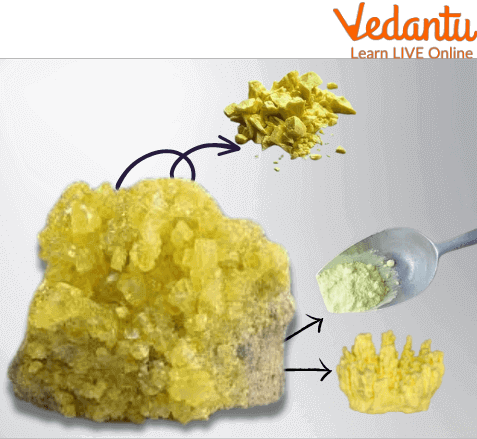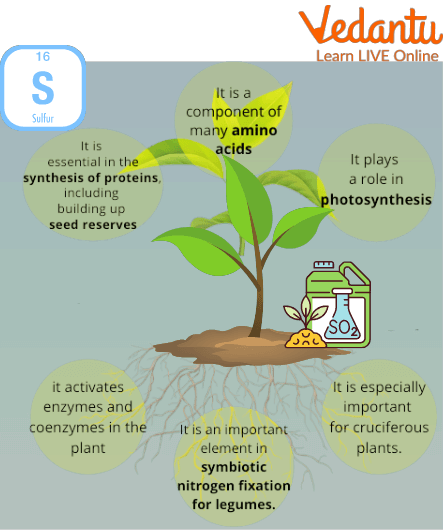




Overview of Sulphur
A naturally occurring element called sulphur encourages the more effective use of Earth's resources. It is a vital essential nutrient in agriculture, a crucial component of sustainable urban development, as well as a crucial component in initiatives to halt the loss of arable farmland due to soil degradation.
In this article, we will read about sulphur. Towards the end, we will be aware of 10 uses of sulphur and almost everything important information about sulphur. We will also discover the significance that sulphur plays in our daily lives.
What is Sulphur?
Sulphur is a plentiful, multivalent non-metal that has no flavour or odour. Sulphur is a yellow solid substance in its natural state. It can be found in nature either as a pure metal or as sulphide and sulphate minerals. Although sulphur is notorious for its stench, which is commonly compared to rotten eggs, hydrogen sulphide has that scent (H2S).
Pure sulphur is a tasteless, odourless, rigid solid with a pale yellow colour that is insoluble in water and a poor conductor of electricity. It creates sulphides when it combines with all metals, excluding gold and platinum, and it also does so when it interacts with a number of nonmetallic elements.
Sulphur crystallography is intricate. Sulphur allotropes can produce a variety of unique crystal forms depending on the circumstances. Sulphur may have made it feasible for life to exist on Earth. The variety of amino acids that make up the basis of life might have been produced by straightforward chemical reactions earlier, in the seas.
Sulphur naturally occurs close to volcanoes. Massive amounts of native sulphur are found naturally in Texas and Louisiana in the United States. Numerous sulphide minerals are recognised, including sphalerite, zinc sulphide, stibnite, antimony sulphide, galena, lead sulphide, pyrite, and marcasite, which are both iron sulphides. Chalcopyrite, bornite, pentlandite, millerite, and molybdenite are additional, more significant sulphide ores.

Sulphur Physical Form
Uses of Sulphur
In addition to being a fungicide and an ingredient in black gunpowder, sulphur is used for vulcanising black rubber. However, the majority of sulphur is utilised in the creation of sulfuric acid, which is arguably the most significant chemical produced by western civilisations. The production of phosphoric acid to create phosphates for fertilisers is the most significant of sulfuric acid's various applications.
A class of organosulfur compounds is known as mercaptans. Some of these are supplied to natural gas supply so that leaks can be quickly discovered due to their particular odour. Others are employed in the creation of insecticides and herbicides as well as in the polishing of silver.
Sulfites are used in many foods as preservatives and to bleach paper. Sulphate derivatives are present in many surfactants and detergents. For usage in cement and plaster, 100 million tonnes of calcium sulphate (gypsum) are mined annually.
Uses of Sulphur in Plants

Role of Sulphur in Plants
Numerous plant growth processes, such as nitrogen fixation, enzyme activity, protein and oil synthesis, depend on sulphur. Sulphur-deficient plants typically feature short and/or lanky stems, and young (top) leaves that have yellowed. When there is a nitrogen shortage, the older leaves are the first to yellow. In addition, immature leaves may purpling and cup upward, flowering may be delayed and extended, the flowers may be pale in colour, and the pods may be fewer and smaller in sulphur-deficiency canola.
Uses of Sulphur for Skin
All living tissues include the chemical element sulphur. It ranks third among the most prevalent minerals in the human body, behind calcium and phosphorus. Broccoli, onions, and garlic also contain sulphur.
Shortness of breath, allergies, pharyngitis (swelling at the back of the throat), heart problems, blocked arteries, menopausal, and respiratory tract infections like the cold virus are all treated with sulphur taken orally.
Sulphur is administered topically to the skin to treat conditions like rosacea, dandruff, scabies, lice, cold sores, warts, and infections from poison oak, ivy, and sumac in addition to acne, hay fever, skin redness, acne, and dandruff.
Summary
Sulphur is a non-metallic chemical element with the atomic number 16 and the chemical symbol S It is extremely reactive yet can be found naturally in deposits, coupled in other ores (such as pyrite, galena, and cinnabar), in coal, petroleum, and natural gas, as well as in sulphur spring water.
Sulphur is one of the four most significant basic chemical commodities and the third most common mineral component. One of the largest industrial uses of sulphur is that it is used in making phosphate fertilisers. We will wrap up this article here only.
FAQs on Uses of Sulphur
1. How is sulphuric acid made?
Sulphuric acid is formed as a by-product of non-ferrous and ferrous metal smelting that contains sulphur.
2. Who discovered sulphate from sulphur?
The elemental nature of sulphur was established in 1809 by the French scientists Louis-Joseph Gay-Lussac and Louis-Jacques Thenard.
3. How was sulphur first given its name?
The Latin word "sulphur," is derived from a Latin root that means "to burn," which gives sulphur its name.









